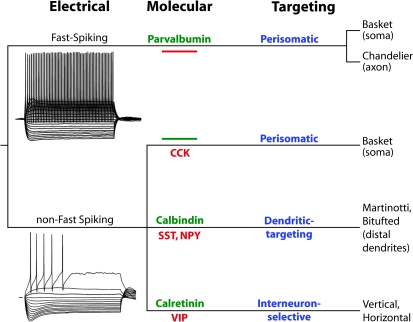Fig. 2.
Highly simplified view of the γ-aminobutyric acid (GABA) neuron subtypes revealed by the combined analysis of electrical, molecular, and morphological properties. Electrophysiological properties divide interneurons into 2 major clusters, fast spiking (FS) and non-fast spiking (non-FS), based on the response of the neurons’ membrane potential to direct injection of current. FS neurons form a relatively homogeneous group of interneurons that contain the calcium-binding protein parvalbumin (PV), contain no neuropeptides, and make synapses onto the perisomatic compartment of the postsynaptic pyramidal cell. FS/PV basket cells synapse onto the proximal dendrites and soma of pyramidal cells and also onto other GABA neurons. FS/PV chandelier cells synapse onto the axon initial segment of pyramidal cells but not onto other GABA neurons. The non-FS cell cluster is largely heterogeneous, containing 2 electrical subgroups, the RSNP and the BSNP neurons, the latter are also called low-threshold spiking cells (see text for additional details). An important group of non-FS cells are the Martinotti neurons, which in most cases contain the calcium-binding protein calbindin (CB) and the neuropeptides somatostatin (SST) and neuropeptide Y (NPY). Martinotti cells make synapses onto the distal dendrites of pyramidal cells. The subgroup of non-FS cells that contain the calcium-binding protein calretinin (CR) also express vasoactive intestinal peptide (VIP) and make contacts onto other GABA neurons much more frequently than onto pyramidal cells and thus are called interneuron selective. The non-FS basket cells containing cholecystokinin (CCK) do not contain PV, CB, or CR and make synapses onto the perisomatic compartment of postsynaptic pyramidal cells.

